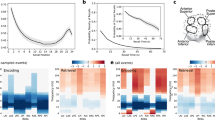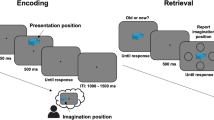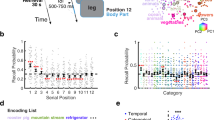Abstract
Can the brain improve the retrievability of an experience after it has occurred? Systems consolidation theory proposes that item-specific cortical reactivation during post-encoding rest periods facilitates the formation of stable memory representations, a prediction supported by neural evidence in humans and animals. Such reactivation may also occur on shorter timescales, offering a potential account of classic list memory phenomena but lacking in support from neural data. Leveraging the high temporal specificity of intracranial electroencephalography (EEG), we investigate spontaneous reactivation of previously experienced items during brief intervals between individual encoding events. Across two large-scale free-recall experiments, we show that reactivation during these periods, measured by spectral intracranial EEG similarity, predicts subsequent recall. In a third experiment, we show that the same methodology can identify post-encoding reactivation that correlates with subsequent memory, consistent with previous results. Thus, spontaneous study-phase reinstatement reliably predicts memory behavior, linking psychological accounts to neural mechanisms and providing evidence for rapid consolidation processes during encoding.
This is a preview of subscription content, access via your institution
Access options
Access Nature and 54 other Nature Portfolio journals
Get Nature+, our best-value online-access subscription
$32.99 / 30 days
cancel any time
Subscribe to this journal
Receive 12 print issues and online access
$259.00 per year
only $21.58 per issue
Buy this article
- Purchase on SpringerLink
- Instant access to full article PDF
Prices may be subject to local taxes which are calculated during checkout




Similar content being viewed by others
Data availability
De-identified data from the three experiments in this study are available on OpenNeuro (experiment 1, https://openneuro.org/datasets/ds004809/; experiment 2, https://openneuro.org/datasets/ds004789/; experiment 3, https://openneuro.org/datasets/ds005411/).
Code availability
The software used to perform analyses and generate figures for the paper is available on GitHub at https://github.com/pennmem/study_phase_reinstatement.
References
Zhang, H., Fell, J. & Axmacher, N. Electrophysiological mechanisms of human memory consolidation. Nat. Commun. 9, 4103 (2018).
Staresina, B. P., Alink, A., Kriegeskorte, N. & Henson, R. N. Awake reactivation predicts memory in humans. Proc. Natl Acad. Sci. USA 110, 21159–21164 (2013).
Deuker, L. et al. Memory consolidation by replay of stimulus-specific neural activity. J. Neurosci. 33, 19373–19383 (2013).
Schapiro, A. C., McDevitt, E. A., Rogers, T. T., Mednick, S. C. & Norman, K. A. Human hippocampal replay during rest prioritizes weakly learned information and predicts memory performance. Nat. Commun. 9, 3920 (2018).
Marr, D. Simple memory: a theory for archicortex. Philos. Trans. R. Soc. Lond. B Biol. Sci. 262, 23–81 (1971).
Buzsáki, G. Two-stage model of memory trace formation: a role for ‘noisy’ brain states. Neuroscience 31, 551–570 (1989).
McClelland, J. L., McNaughton, B. L. & O’Reilly, R. C. Why there are complementary learning systems in the hippocampus and neocortex: insights from the successes and failures of connectionist models of learning and memory. Psychol. Rev. 102, 419–457 (1995).
Wilson, M. & McNaughton, B. Reactivation of hippocampal ensemble memories during sleep. Science 265, 676–679 (1994).
Carr, M. F., Jadhav, S. P. & Frank, L. M. Hippocampal replay in the awake state: a potential substrate for memory consolidation and retrieval. Nat. Neurosci. 14, 147–153 (2011).
Benjamin, A. S. & Tullis, J. What makes distributed practice effective? Cogn. Psychol. 61, 228–247 (2010).
Ward, G. & Tan, L. The role of rehearsal and reminding in the recall of categorized word lists. Cogn. Psychol. 143, 101563 (2023).
Thios, S. J. & D’Agostino, P. R. Effects of repetition as a function of study-phase retrieval. J. Verbal Learning Verbal Behav. 15, 529–536 (1976).
Siegel, L. L. & Kahana, M. J. A retrieved context account of spacing and repetition effects in free recall. J. Exp. Psychol. Learn. Mem. Cogn. 40, 755–764 (2014).
Hintzman, D. L., Summers, J. J. & Block, R. A. Spacing judgments as an index of study-phase retrieval. J. Exp. Psychol. Hum. Learn. Mem. 1, 31–40 (1975).
Rundus, D. Analysis of rehearsal processes in free recall. J. Exp. Psychol. 89, 63–77 (1971).
Rundus, D. & Atkinson, R. C. Rehearsal processes in free recall: a procedure for direct observation. J. Verbal Learning Verbal Behav. 9, 99–105 (1970).
Modigliani, V. & Hedges, D. G. Distributed rehearsals and the primacy effect in single-trial free recall. J. Exp. Psychol. Learn. Mem. Cogn. 13, 426–436 (1987).
Bird, C. M., Keidel, J. L., Ing, L. P., Horner, A. J. & Burgess, N. Consolidation of complex events via reinstatement in posterior cingulate cortex. J. Neurosci. 35, 14426–14434 (2015).
Fellner, M.-C., Waldhauser, G. T. & Axmacher, N. Tracking selective rehearsal and active inhibition of memory traces in directed forgetting. Curr. Biol. 30, 2638–2644 (2020).
Honey, C. J., Newman, E. L. & Schapiro, A. C. Switching between internal and external modes: a multiscale learning principle. Netw. Neurosci. 1, 339–356 (2017).
Mednick, S. C., Cai, D. J., Shuman, T., Anagnostaras, S. & Wixted, J. T. An opportunistic theory of cellular and systems consolidation. Trends Neurosci. 34, 504–514 (2011).
Norman, K. A., Newman, E. L. & Perotte, A. J. Methods for reducing interference in the complementary learning systems model: oscillating inhibition and autonomous memory rehearsal. Neural Netw. 18, 1212–1228 (2005).
Wamsley, E. J., Arora, M., Gibson, H., Powell, P. & Collins, M. Memory consolidation during ultra-short offline states. J. Cogn. Neurosci. 35, 1617–1634 (2023).
Wamsley, E. J. & Summer, T. Spontaneous entry into an ‘offline’ state during wakefulness: a mechanism of memory consolidation? J. Cogn. Neurosci. 32, 1714–1734 (2020).
Xue, G. et al. Greater neural pattern similarity across repetitions is associated with better memory. Science 330, 97–101 (2010).
Lu, Y., Wang, C., Chen, C. & Xue, G. Spatiotemporal neural pattern similarity supports episodic memory. Curr. Biol. 25, 780–785 (2015).
Ebbinghaus, H. Memory: A Contribution to Experimental Psychology (Teachers College Press, 1913).
Madigan, S. A. Intraserial repetition and coding processes in free recall. J. Verbal Learning Verbal Behav. 8, 828–835 (1969).
Melton, A. W. The situation with respect to the spacing of repetitions and memory. J. Verbal Learning Verbal Behav. 9, 596–606 (1970).
Greene, R. L. Spacing effects in memory: evidence for a two-process account. J. Exp. Psychol. Learn. Mem. Cogn. 15, 371–377 (1989).
Feng, K. et al. Spaced learning enhances episodic memory by increasing neural pattern similarity across repetitions. J. Neurosci. 39, 5351–5360 (2019).
Wu, X. & Fuentemilla, L. Distinct encoding and post-encoding representational formats contribute to episodic sequence memory formation. Cereb. Cortex 33, 8534–8545 (2023).
Wu, X., Viñals, X., Ben-Yakov, A., Staresina, B. P. & Fuentemilla, L. Post-encoding reactivation is related to learning of episodes in humans. J. Cogn. Neurosci. 35, 74–89 (2022).
Edelman, S., Grill-Spector, K., Kushnir, T. & Malach, R. Toward direct visualization of the internal shape representation space by fMRI. Psychobiology 26, 309–321 (1998).
Sommer, V. R., Mount, L., Weigelt, S., Werkle-Bergner, M. & Sander, M. C. Spectral pattern similarity analysis: tutorial and application in developmental cognitive neuroscience. Dev. Cogn. Neurosci. 54, 101071 (2022).
Manning, J. R., Polyn, S. M., Baltuch, G. H., Litt, B. & Kahana, M. J. Oscillatory patterns in temporal lobe reveal context reinstatement during memory search. Proc. Natl Acad. Sci. USA 108, 12893–12897 (2011).
Manning, J. R., Sperling, M. R., Sharan, A., Rosenberg, E. A. & Kahana, M. J. Spontaneously reactivated patterns in frontal and temporal lobe predict semantic clustering during memory search. J. Neurosci. 32, 8871–8878 (2012).
Fisher, R. A. Frequency distribution of the values of the correlation coefficient in samples from an indefinitely large population. Biometrika 10, 507–521 (1915).
Kragel, J. E. et al. Distinct cortical systems reinstate the content and context of episodic memories. Nat. Commun. 12, 4444 (2021).
Haxby, J. V. Distributed and overlapping representations of faces and objects in ventral temporal cortex. Science 293, 2425–2430 (2001).
Howard, M. W. & Kahana, M. J. When does semantic similarity help episodic retrieval? J. Mem. Lang. 46, 85–98 (2002).
Sanquist, T. F., Rohrbaugh, J. W., Syndulko, K. & Lindsley, D. B. Electrocortical signs of levels of processing: perceptual analysis and recognition memory. Psychophysiology 17, 568–576 (1980).
Fernández, G. et al. Real-time tracking of memory formation in the human rhinal cortex and hippocampus. Science 285, 1582–1585 (1999).
Fell, J. et al. Human memory formation is accompanied by rhinal–hippocampal coupling and decoupling. Nat. Neurosci. 4, 1259–1264 (2001).
Dewar, M., Alber, J., Cowan, N. & Della Sala, S. Boosting long-term memory via wakeful rest: intentional rehearsal is not necessary, consolidation is sufficient. PLoS ONE 9, e109542 (2014).
Tambini, A. & Davachi, L. Awake reactivation of prior experiences consolidates memories and biases cognition. Trends Cogn. Sci. 23, 876–890 (2019).
Howard, M. W., Viskontas, I. V., Shankar, K. H. & Fried, I. Ensembles of human MTL neurons ‘jump back in time’ in response to a repeated stimulus. Hippocampus 22, 1833–1847 (2012).
Estes, W. K. Statistical theory of spontaneous recovery and regression. Psychol. Rev. 62, 145–154 (1955).
Howard, M. W. & Kahana, M. J. A distributed representation of temporal context. J. Math. Psychol. 46, 269–299 (2002).
Zola-Morgan, S. M. & Squire, L. R. The primate hippocampal formation: evidence for a time-limited role in memory storage. Science 250, 288–290 (1990).
Anagnostaras, S. G., Maren, S. & Fanselow, M. S. Temporally graded retrograde amnesia of contextual fear after hippocampal damage in rats: within-subjects examination. J. Neurosci. 19, 1106–1114 (1999).
Tse, D. et al. Schemas and memory consolidation. Science 316, 76–82 (2007).
Craik, F. I. & Watkins, M. J. The role of rehearsal in short-term memory. J. Verbal Learning Verbal Behav. 12, 599–607 (1973).
Cousineau, D. Confidence intervals in within-subject designs: a simpler solution to Loftus and Masson’s method. Tutor. Quant. Methods Psychol. 1, 42–45 (2005).
Lenth, R. emmeans: Estimated Marginal Means, aka Least-Squares Means CRAN.R-project.org/package=emmeans (2019).
Loftus, G. R. & Masson, M. E. J. Using confidence intervals in within-subject designs. Psychon. Bull. Rev. 1, 476–490 (1994).
Franz, V. H. & Loftus, G. R. Standard errors and confidence intervals in within-subjects designs: generalizing Loftus and Masson (1994) and avoiding the biases of alternative accounts. Psychon. Bull. Rev. 19, 395–404 (2012).
Weidemann, C. T. et al. Neural activity reveals interactions between episodic and semantic memory systems during retrieval. J. Exp. Psychol. Gen. 148, 1–12 (2019).
Deerwester, S., Dumais, S. T., Furnas, G. W., Landauer, T. K. & Harshman, R. Indexing by latent semantic analysis. J. Am. Soc. Inf. Sci. 41, 391–407 (1990).
Landauer, T. K. & Dumais, S. T. A solution to Plato’s problem: the latent semantic analysis theory of acquisition, induction, and representation of knowledge. Psychol. Rev. 104, 211–240 (1997).
Geller, A. S., Schleifer, I. K., Sederberg, P. B., Jacobs, J. & Kahana, M. J. PyEPL: a cross-platform experiment-programming library. Behav. Res. Methods 39, 950–958 (2007).
Anderson, K. L., Rajagovindan, R., Ghacibeh, G. A., Meador, K. J. & Ding, M. Theta oscillations mediate interaction between prefrontal cortex and medial temporal lobe in human memory. Cereb. Cortex 20, 1604–1612 (2010).
SciPy 1.0 Contributors et al. SciPy 1.0: fundamental algorithms for scientific computing in Python. Nat. Methods 17, 261–272 (2020).
Hoyer, S. & Hamman, J. xarray: N-D labeled arrays and datasets in Python. J. Open Res. Softw. 5, 10 (2017).
McKinney, W. Data structures for statistical computing in Python. In Proceedings of the 9th Python in Science Conference (eds van der Walt, S. & Millman, J.) 56–61 (Curvenote, 2010).
Harris, C. R. et al. Array programming with NumPy. Nature 585, 357–362 (2020).
Waskom, M. seaborn: statistical data visualization. J. Open Source Softw. 6, 3021 (2021).
Bates, D., Mächler, M., Bolker, B. & Walker, S. Fitting linear mixed-effects models using lme4. J. Stat. Softw. 67, 1–48 (2015).
Kuznetsova, A., Brockhoff, P. B. & Christensen, R. H. B. lmerTest package: tests in linear mixed effects models. J. Stat. Softw. 82, 1–26 (2017).
Satterthwaite, F. E. An approximate distribution of estimates of variance components. Biometrics 2, 110–114 (1946).
Giesbrecht, F. G. & Burns, J. C. Two-stage analysis based on a mixed model: large-sample asymptotic theory and small-sample simulation results. Biometrics 41, 477–486 (1985).
Hrong-Tai Fai, A. & Cornelius, P. L. Approximate F-tests of multiple degree of freedom hypotheses in generalized least squares analyses of unbalanced split-plot experiments. J. Stat. Comput. Simul. 54, 363–378 (1996).
Bates, D., Kliegl, R., Vasishth, S. & Baayen, H. Parsimonious mixed models. Preprint at https://arxiv.org/abs/1506.04967 (2018).
Wickham, H. et al. Welcome to the tidyverse. J. Open Source Softw. 4, 1686 (2019).
R Core Team. R: A Language and Environment for Statistical Computing (R Foundation for Statistical Computing, 2020).
Acknowledgements
We are very grateful to all patients who participated in this study. We thank R. Colyer, A. Rao and R. DeHaan for help with data collection and quality control and A. Schapiro, A. Broitman and N. Greene for comments on the paper. We gratefully acknowledge support from NIH grant MH55687.
Author information
Authors and Affiliations
Contributions
D.J.H. and M.J.K. developed hypotheses and designed the study. M.J.K. acquired funding. B.C.L., R.E.G., C.W., M.R.S., J.P.A. and B.C.J. recruited study participants, implanted electrodes and collected data. D.J.H. analyzed data. D.J.H. and M.J.K. wrote the paper.
Corresponding author
Ethics declarations
Competing interests
The authors declare no competing interests.
Peer review
Peer review information
Nature Neuroscience thanks John Wixted and the other, anonymous, reviewer(s) for their contribution to the peer review of this work.
Additional information
Publisher’s note Springer Nature remains neutral with regard to jurisdictional claims in published maps and institutional affiliations.
Supplementary information
Supplementary Information
Supplementary Figs. 1–3 and Discussion.
Rights and permissions
Springer Nature or its licensor (e.g. a society or other partner) holds exclusive rights to this article under a publishing agreement with the author(s) or other rightsholder(s); author self-archiving of the accepted manuscript version of this article is solely governed by the terms of such publishing agreement and applicable law.
About this article
Cite this article
Halpern, D.J., Lega, B.C., Gross, R.E. et al. Study-phase reinstatement predicts subsequent recall. Nat Neurosci 28, 883–890 (2025). https://doi.org/10.1038/s41593-025-01884-8
Received:
Accepted:
Published:
Issue date:
DOI: https://doi.org/10.1038/s41593-025-01884-8
This article is cited by
-
Memory consolidation accelerates
Nature Neuroscience (2025)



